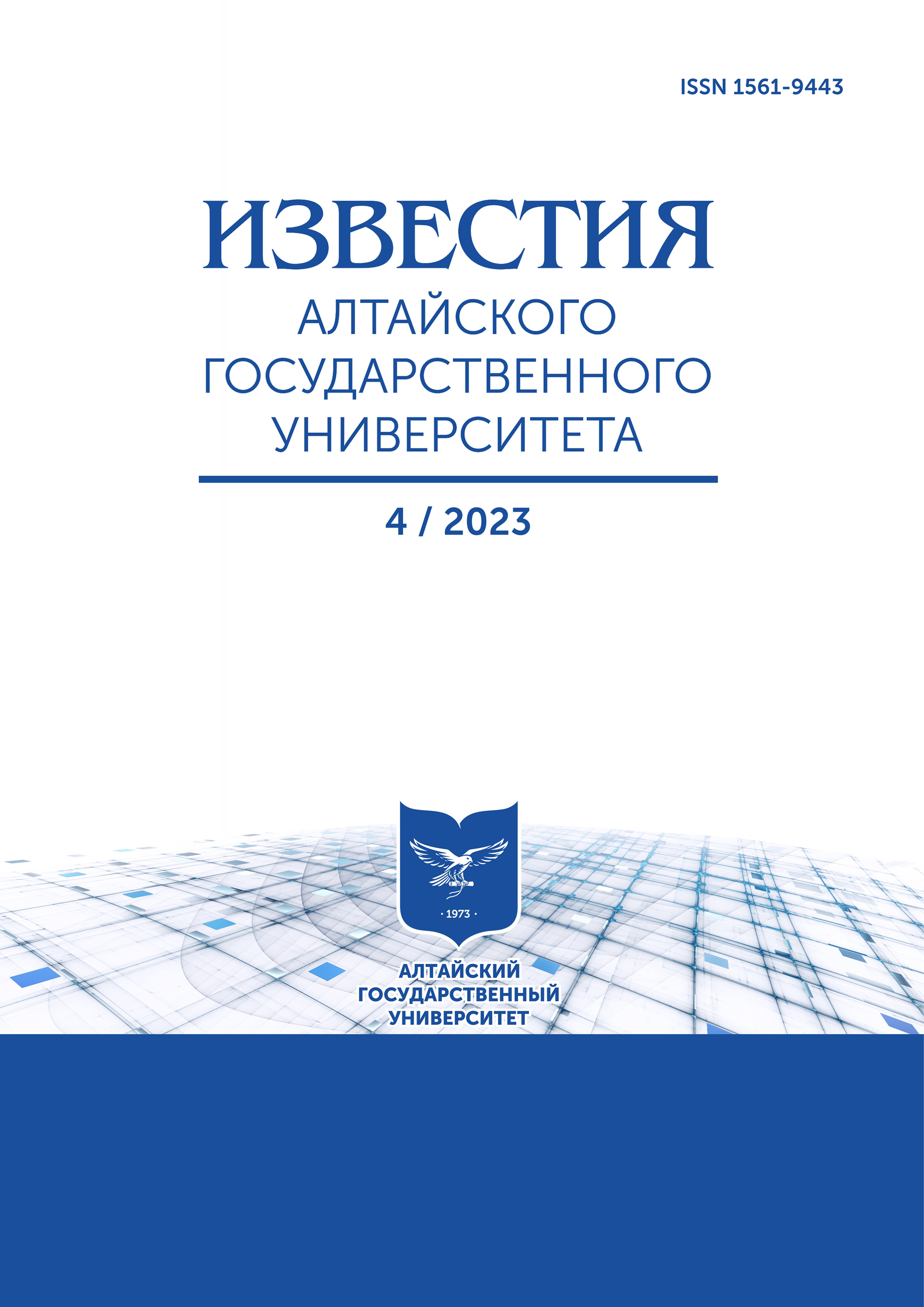Study of Microhardness and Plasticity Parameter of Lead in External Magnetic Fields with Induction up to 0.5 T
УДК 538.9:669.713.017
Abstract
Microhardness tests of samples of technically pure lead are carried out without and with exposure to external magnetic fields with inductions of 0.3 T, 0.4 T, and 0.5 T. The dependences of the C2-grade lead surface microhardnesses on the exposure times in a magnetic field are obtained, thus reflecting the influence of the magnetic field on the plastic characteristics of lead. The exposure time at which the maximum effect on microhardness occurs is revealed. Additional microhardness tests are carried out for cases with magnetic fields with inductions of up to 0.3, 0.4, and 0.5 T and exposure times of 0.25, 0.5, and 1 hour. Following the obtained microhardness data, the plasticity parameters of lead samples in their initial state and after exposure are calculated. The dependences of the plasticity parameters on the exposure times are shown. The behavior of the plasticity parameter of lead samples during their exposure to external magnetic field with induction up to 0.5 T is revealed. The percent changes in the values of microhardness depending on the magnetic field induction are shown.
Downloads
Metrics
References
Ida N. The Static Magnetic Field // In book: Engineering Electromagnetics. 2021. № 377.
Gillon P. Uses of intense d.c. magnetic fields in materials processing // Materials Science and Engineering: A. 2000. № 287.
Yasuda H., Molokov S., Moreau R., Moffatt K. Applications of High Magnetic Fields in Materials Processing. 2007. № 329. https://doi.org/10.1007/978-1-4020-4833-3_20
Balaji S. Magnetic Fields in Materials. 2020. 355. https:// doi.org/10.1007/978-981-15-2658-9_5
Papaefthymiou G. Magnetic Fields in Materials. 2022. № 3. https://doi.org/10.1007/978-981-15-2658-9_510.1201/ 9781315157016-2
Watanabe K., Motokawa M. Materials Science in Static High Magnetic Fields. 2002. https://doi.org/10.1007/978-3-642-56312-6
Asai S. Application of High Magnetic Fields in Materials Processing // Cheminform. 2006. № 37 (24). https://doi. org/10.1002/chin.200624224
Краев M., Краева В. Влияние постоянного магнитного поля на сопротивление деформации и упрочнение металлов // Актуальные проблемы прочности : международная научная конференция. Витебск, 2018.
Шляров В.В., Загуляев Д.В. Фундаментальные проблемы современного материаловедения. 2019. https://doi. org/10.25712/ASTU. 1811-1416.2019.03.016
Краев M. Космические технологии: настоящее и будущее : материалы 6-й Международной конференции ГП КБЮ, Днепр 75. 2017.
Misra P. Diamagnetism and Paramagnetism. 2012. https://doi.org/10.1016/B978-0-12-384954-0.00012-8
Pollock D. Diamagnetic and Paramagnetic Effects. 2020. 269. https://doi.org/10.1201/9781003068082-8
Kadhem M. Ferromagnetism and Antiferromagnetism. 2014. https://doi.org/10.13140/2.1.4618.1449
Ketterson J. Ferromagnetism and Antiferromagnetism. 2016. № 519. https://doi.org/54510.1093/acprof:oso/ 9780198742906.003.0026
Романтеев Ю.П. Металлургия тяжелых цветных металлов. Свинец. Цинк. Кадмий. МИСИС. М., 2010.
Коновалов С.В. Автоматизированная установка для регистрации и анализа ползучести металлов и сплавов // Заводская лаборатория. Диагностика материалов. 2007. № 8.
ГОСТ Р 8.748-2011. Металлы и сплавы. Измерение твердости и других характеристик материалов при инструментальном индентировании. М., 2013.
Мильман Ю.В. Масштабная зависимость твердости и характеристики пластичности, определяемой при индентировании // Деформация и разрушение материалов. 2008. № 8.
Головин Ю.И., Моргунов Р.Б., Лопатин Д.В. Обратимые и необратимые изменения пластических свойств кристаллов NaCl, вызванные действием магнитного поля // ФТТ. 1998. № 11.
Copyright (c) 2023 Анна Александровна Серебрякова , Дмитрий Валерьевич Загуляев , Виталий Владиславович Шляров , Виктор Евгеньевич Громов , Крестина Владимировна Аксенова

This work is licensed under a Creative Commons Attribution 4.0 International License.
Izvestiya of Altai State University is a golden publisher, as we allow self-archiving, but most importantly we are fully transparent about your rights.
Authors may present and discuss their findings ahead of publication: at biological or scientific conferences, on preprint servers, in public databases, and in blogs, wikis, tweets, and other informal communication channels.
Izvestiya of Altai State University allows authors to deposit manuscripts (currently under review or those for intended submission to Izvestiya of Altai State University) in non-commercial, pre-print servers such as ArXiv.
Authors who publish with this journal agree to the following terms:
- Authors retain copyright and grant the journal right of first publication with the work simultaneously licensed under a Creative Commons Attribution License (CC BY 4.0) that allows others to share the work with an acknowledgement of the work's authorship and initial publication in this journal.
- Authors are able to enter into separate, additional contractual arrangements for the non-exclusive distribution of the journal's published version of the work (e.g., post it to an institutional repository or publish it in a book), with an acknowledgement of its initial publication in this journal.
- Authors are permitted and encouraged to post their work online (e.g., in institutional repositories or on their website) prior to and during the submission process, as it can lead to productive exchanges, as well as earlier and greater citation of published work (See The Effect of Open Access).








